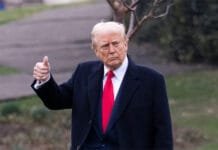Donald Trump’s Vision Before Taking Office: Bold Agendas and Global Shifts
As Donald Trump prepares to take the oath of office for his second term as the President of the United States on January 20, he has outlined a series of bold and controversial initiatives that could significantly alter the trajectory of both the U.S. and the global landscape. During a press conference held at his Mar-a-Lago estate in Florida, Trump unveiled his comprehensive agenda that covers a wide range of topics, from national security and foreign policy to economic matters and international diplomacy. This article delves into the key elements of Trump’s pre-presidency agenda, shedding light on his most talked-about proposals.
Canada’s Future: A Bold Proposal for Integration with the U.S.
One of the most startling suggestions made by Trump during his recent press conference was his proposal to make Canada the 51st state of the United States. The former president emphasized that this move would strengthen the national security of both nations, offering a unified front against global threats. According to Trump, economic security plays a pivotal role in this idea, stating that the U.S. can no longer afford to support Canada financially.
Economic Pressures and Tariffs on Canada
Trump hinted at the possibility of imposing tariffs on Canadian imports as a strategy to compel the country to join the U.S. in a formal union. He argued that the economic cooperation between the U.S. and Canada should evolve into a more formal arrangement, with the Canadian economy benefiting from the robust financial infrastructure of the United States.
While many critics have dismissed the idea as highly impractical, it is clear that Trump views this proposal as a significant opportunity to reinforce U.S. economic dominance in North America. With global competition intensifying, the notion of an economic alliance between the two nations remains an intriguing and divisive topic.
The Gaza Hostage Crisis: Trump’s Direct Warning to Hamas
Trump also addressed the ongoing hostage situation in Gaza, where several Israeli citizens remain in the custody of Hamas. The former president issued a stern warning to the militant group, stating that if the hostages are not returned before he takes office, he would take decisive action to resolve the crisis. Trump made it clear that such a situation would not only be detrimental to the region but would also have profound global consequences.
Trump’s tough stance on Hamas reflects his broader Middle East policy, which seeks to confront terrorism head-on. His administration’s commitment to securing the release of these hostages underscores his willingness to take aggressive measures to ensure American and Israeli security.
Restoring Stability in the Middle East
Trump’s rhetoric on Gaza is part of a larger Middle East strategy aimed at reinforcing U.S.-Israel relations and countering the influence of radical groups in the region. His previous term saw significant steps in this direction, such as the Abraham Accords, which normalized relations between Israel and several Arab nations. Trump’s proposed policies suggest that he intends to continue his aggressive stance on terrorism while fostering peace agreements that align with American interests.
Renaming the Gulf: The “America’s Gulf” Initiative
In another provocative move, Trump announced plans to rename the Gulf of Mexico, calling it America’s Gulf. According to Trump, this name change is not just a symbolic gesture but an assertion of U.S. territorial interests and influence over the region. While the proposal has been met with mixed reactions, the underlying message is clear: Trump aims to elevate America’s status on the global stage, making a bold statement about the nation’s dominance in the Western Hemisphere.
Though the details of this plan remain sparse, it serves as an example of Trump’s tendency to push for significant alterations in international naming conventions and boundaries. His proposals often come with the promise of strong leadership, an approach that has garnered both support and criticism in equal measure.
Control Over the Panama Canal and Greenland: Strategic Military Interests
Trump also reiterated his desire to exert greater control over the Panama Canal and Greenland, two strategically important areas that he views as crucial to U.S. national security. In the press conference, Trump indicated that he would not rule out the use of military force to assert American dominance over these regions if necessary.
The Panama Canal: A Hub of Global Trade and Security Concerns
Trump’s concerns over the Panama Canal are rooted in its significant role as a major trade route. Currently, China controls many of the operations within the canal, a situation Trump described as a misuse of power. He emphasized the importance of regaining control over the canal to ensure that it operates in alignment with U.S. interests.
Greenland: A Strategic Outpost
Trump’s interest in Greenland is not new. In his first term, he controversially proposed the purchase of the territory, citing its geopolitical importance and natural resources. Greenland’s location near the Arctic makes it a key site for military and economic strategies, especially with the increasing focus on the region due to climate change and resource exploration.
Trump has made it clear that he views both regions as essential to the U.S. global presence, believing that American influence in these areas is necessary for security and economic stability.
Elon Musk and Controversial Public Statements
During the press conference, Trump also addressed the controversial role of Elon Musk, the CEO of Tesla and other companies, in his administration. Musk’s outspoken comments, particularly those related to foreign affairs and global politics, have raised eyebrows. Trump, however, refrained from commenting on Musk’s most contentious statements but praised him for his contributions to the U.S. economy and his efforts to advance technological innovation.
Despite the media frenzy surrounding Musk’s remarks, Trump maintained that the billionaire entrepreneur is a valuable asset to the American workforce and will play an important role in his second term’s economic strategy.
NATO: A Push for Increased Defense Spending
Trump also reiterated his stance on NATO, urging member countries to increase their defense spending to 5% of GDP. This marks a significant departure from the 2% goal established in previous years, with Trump arguing that NATO members can afford to contribute more to collective defense efforts. His position is based on the belief that the U.S. should not bear the brunt of the alliance’s costs, especially given the financial strain faced by American taxpayers.
A Stronger, More Autonomous NATO
Trump’s proposal reflects his broader view of NATO as a vital yet increasingly self-sufficient entity. He has consistently criticized the alliance for its reliance on the U.S. and has pushed for European nations to shoulder more of the financial and military burdens. His call for increased defense spending underscores his belief that NATO must evolve to meet the changing dynamics of global security.
Reversing Biden’s Policies: A Shift Toward Energy Independence
Another major component of Trump’s agenda is the reversal of several key policies enacted by President Joe Biden. In particular, Trump has promised to lift restrictions on offshore oil and gas drilling, which were imposed by the Biden administration in an effort to combat climate change.
Trump has consistently argued that energy independence is crucial for both economic growth and national security, and he plans to reinstate policies that promote the exploration and extraction of fossil fuels from U.S. waters.
A Future Focused on Energy Security
By reintroducing oil and gas drilling, Trump aims to reduce America’s reliance on foreign energy sources and restore jobs in the energy sector. His approach seeks to balance economic growth with national interests, positioning the U.S. as an energy superpower once again.
A New Era of U.S. Global Leadership
As Donald Trump prepares to assume office once again, his proposed policies signal a shift toward more aggressive international engagement, with a strong emphasis on national security, economic dominance, and strategic military positioning. From potentially integrating Canada into the U.S. to asserting control over critical global assets, Trump’s agenda is one that prioritizes American strength and influence on the world stage. Whether these proposals will be realized remains to be seen, but one thing is certain: the coming years under Trump’s leadership promise to be marked by bold actions and unprecedented shifts in global politics.















